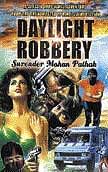If there are literary seasons, then I guess the current is one of the hottest in a long time. A thriller from the king of Hindi crime fiction, Surender Mohan Pathak, and a mystery from the king of Urdu detective stories, Ibn-e Safi, both freshly translated, arrived on my desk in one parcel tied together with a piece of string, almost like two handcuffed goondas.

Daylight Robbery
Surender Mohan Pathak, Translated by Sudarshan Purohit
Blaft, 2010,
pp 236, Rs 195
Daylight Robbery, with its attractive pulp cover by legendary Shelle Studio, is the second title by Pathak to be translated into crisp, hardboiled English by Sudarshan Purohit. Already last year I’d been bowled over by The 65 Lakh Heist and I am glad to hear that the series will continue with at least one more translation, the shortly forthcoming Fortune’s Ransom.
These three belong in the ‘Vimal Series’. The story goes that Pathak had written 40 novels about a crime-solving journalist called Sunil, a good guy, but needed a different hero to fit more sordid plot ideas. So he created Vimal, who was framed by his wife and her lover, put in jail on charges of embezzlement, and escaped to become a wanted criminal. The book flopped.
It wasn’t until the fourth novel in the series, The 65 Lakh Heist (1977) about a daring bank-robbery in Amritsar, that Pathak had a bestseller — it has apparently crossed 3,00,000 copies in sales. Taken together Pathak’s approximately 300 books have sold twenty-five to thirty million copies!
Pathak honed his skills by translating James Hadley Chase and James Bond into Hindi, but his great feat is the use of Indian ambiences. Vimal’s adventures take readers on a virtual Bharat Darshan a la noir: in Mumbai he murdered Lady Gokuldas, in Chennai he looted the Anna Stadium, in Delhi he robbed a bank, in Goa he killed a corrupt policeman and just before this present novel begins, Vimal held up a bank truck in Jaipur, where we now find him.
The story follows a standard format: action is followed by reaction, one set action piece leads into the next and the reader is immediately hooked. Vimal must again join some criminals, who want to stage a robbery — this time against an armoured van delivering salaries to a factory in Agra — but they need one daredevil member to pull off the hazardous plan. Vimal is hesitant but the goonda boss brainwashes him.
“All those big crimes that are linked to your name today,” Dwarkanath said, “I know that you’ve committed none of them for your personal benefit. You’ve committed them because you were threatened, coerced, or forced into them by habitual criminals. You’ve never tried to keep a single rupee of the money you got from those crimes. But despite all your noble intentions, the police aren’t going to let you off.”
If all goes well, Vimal can get a new identity, have plastic surgery and live in peace. Of course something goes wrong and suffice it to say that Vimal is a perpetual loser, circumstances conspire against him and that is what makes us root for him.
Apparently Pathak read Urdu pulp like Ibn-e Safi as a kid and coincidentally, the very year, 1980, when the above-reviewed Din dahade dakaiti was originally published, across the border in Pakistan, Ibn-e Safi, Urdu’s first big crime writer, passed away.
For comical effect
The House of Fear
Ibn-e Safi,
Translated by Bilal Tanveer
Random House, 2009, pp 228,
Rs 195
Born in 1928 near Allahabad, Safi was the creator of what is claimed to be the subcontinents best homegrown detective, Ali Imran, MSc, PhD. But only now Safi’s novels are starting to be translated into English: Blaft is publishing the ‘Jasoosi Duniya-series’ espionage novel Dr Dread, HarperCollins have announced 15 forthcoming Imran- and Jasoosi Duniya titles, but first out, from Random House, is The House of Fear.
A dead body has been found in a locked-up house, and a few days later, another turns up in the very same room. Mysteriously, they bear identical injuries from three knives. Imran, a clownish version of Sherlock Holmes, is asked to help crack the case — interestingly nobody knows that he is really the secret boss of the Secret Service, and his antics are so whimsical that even the police suspect he’s an idiot.
Policeman: “Go on with this nonsense.”
Imran: “All right, so I will turn silent. A single silence tancels a chousand talamities... Hain? What is talamities? La haula wala quwwat! What did I say just now?”
Policeman: “Your head!”
Imran: “Yes. Thank you. I have a very strong head. Once it became so strong that I started calling it baigan ka bharta!”
[sic!]
According to the preface, the ‘Imran series’ was considered “polite” enough for the entire family to read, and The House of Fear is clearly written more for comical effect than for nail-biting thrills. By and large, important action is described in hazy brevity, the detective work is sketchy and the plotting relies on old-fashioned tricks of the trade derived from writers like Agatha Christie and Arthur Conan Doyle — like mysterious mansions, highly unrealistic murder methods, and shady crooks who wear false beards.
Yet Safi was one of the biggest publishing phenomena ever in Urdu — he wrote with ballpoint pen and made a carbon copy which was posted to India — and the 245 Imran novels were released simultaneously in both Pakistan and India. It occurred to me that a dialogue-heavy novel like this might actually have worked really well in its original poetic Urdu, but unfortunately it appears blunt in its English translation.
